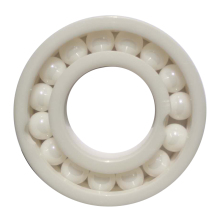Ceramic bearing ceramic structural parts Xingruida bearing supplier
Advantages and disadvantages of ceramic bearings:
1、 Advantages:
1. Because ceramics are hardly afraid of corrosion, ceramic rolling bearings are suitable for operation under harsh conditions full of corrosive media.
2. Because the density of ceramic rolling ball is lower than that of steel and the weight is much lighter, the centrifugal effect on the outer ring during rotation can be reduced by 40%, and the service life can be greatly prolonged.
2、 Disadvantages: difficult processing and high cost.
Advantages and disadvantages of plastic bearings:
1、 Advantages:
1. Plastic bearings are made of lubricating materials as a whole, with long service life;
2. Plastic bearings will not rust in use and are corrosion-resistant, while metal bearings are easy to rust and can not be used in chemical fluids;
3. Plastic bearings are lighter than metal, which is more suitable for the modern lightweight design trend;
2、 Disadvantages: plastic bearings are not resistant to high temperature.
 Audited supplier
Audited supplierThere are many kinds of basic components of lubricating grease. The following is a guide from a professional lubricating grease Co., Ltd. to understand the basic components of lubricating grease. Come and have a look.
Lubricating grease is mainly composed of thickener, basic oil and extender. Ceramic bearing is the best in the new material world because of its incomparable excellent performance, high temperature resistance and super strength. In recent ten years, it has been widely used in various fields of national economy and people's livelihood. Generally, the content of thickener in lubricating grease is about 10% - 20%, the content of basic oil is about 75% - 90%, and the content of extender and filler is within 5%.
l. Base oil
Basic oil is the evacuation medium in the grease evacuation system, which has a great impact on the characteristics of grease. Generally, petroleum lubricating oil with moderate viscosity and high viscosity is selected as the basic oil for lubricating grease, and synthetic lubricating oil is selected as the basic oil for practical mechanical lubrication and sealing under strict standards, such as ester oil, silicone oil, poly olefin oil, etc.
2. Thickener
Thickener is the key component of lubricating grease. The thickener is dispersed in the basic oil and produces the structural skeleton of lubricating grease, so that the basic oil is adsorbed and fixed in the structural skeleton. Ceramic balls are pre fired and rounded at low temperature and sintered and ground at high temperature by dry static press. However, it has been learned recently that precision should be done first, otherwise the hardness will be high after high temperature firing. The water resistance and heat resistance of lubricating grease are determined by thickener. There are two broad categories of thickeners used to prepare greases. Soap based thickeners (i.e. fatty acid metal salts) and non soap based thickeners (hydrocarbons, inorganic and organic).
Soap based thickeners are divided into single soap base (such as calcium base grease), confused soap base (such as calcium sodium base grease) and composite soap base (such as composite calcium base grease). Compared with ordinary bearings, stainless steel bearings not only have obvious advantages in material, but also are much more strict in process and precision control than ordinary bearings. In the working process, stainless steel bearings work stably, have low noise, corrosion resistance and are widely used. 90% of the grease is made of soap based thickener.
3. Additive and filler
A kind of additive is used by lubricating grease, which is called glue solvent. It makes the combination of oil and soap more firm, such as glycerol and water. If water is lost in calcium base grease, its structural culture is completely destroyed and it is impossible to form grease. For example, glycerol may adjust the consistency of grease in sodium base grease.
Another additive is the same as that in lubricating oil, such as anti-oxidation, anti-wear and anti rust agents, but the utilization is usually more than that in lubricating oil. Sometimes, in order to better improve the level of grease resistance to flow and strengthen lubrication, a part of graphite, disulfide key and carbon black are often filled as fillers.
 Audited supplier
Audited supplier
Factory direct sales zirconia ceramic bearings 6202CE XINGRUIDA rolling bearing suppliers

Zirconia ceramic bearing 6200CE high temperature bearing xingruida bearing supplier

Ceramic bearing ceramic structural parts Xingruida bearing supplier

Zirconia full ball ceramic bearing 6205CEF Xingruida corrosion resistant bearing supplier

Factory direct supply deep groove ball bearing 6205-2RS Xingruida rolling bearing custom

Thrust ball plastic bearing 51206 pom Xingruida flat plastic bearing supplier

Manufacturer direct-selling Hybrid Ball Ceramic bearing 6203CE XINGRUIDA bearing supplier

Factory direct export spherical ceramic bearing with seat Xingruida Zirconia ceramic bearing suppliers

Angular contact ball bearing zirconia ceramic bearing 7205CE XINGRUIDA bearing machine tool ceramic bearing factory








